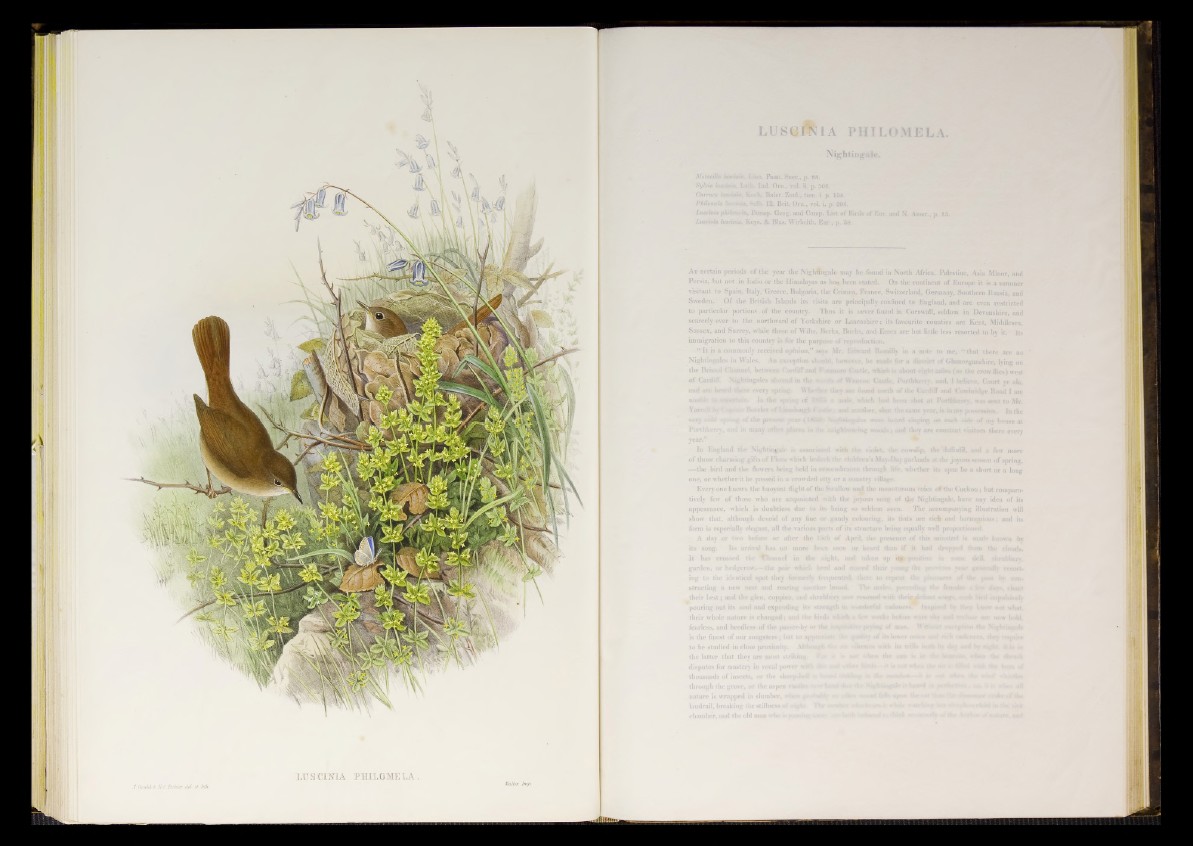
E C RuhUr. dd.eh hth
LU SCm iA PHILOMELA.
lYal/ss. Imp.
Nightingale.
Moiacilm lusclmn. Linn. Faun. Suee., p. 88.
Sylvia btcimti. Lath. lad. Ora., vol. ii. p. 506.
Ourmca Kods, Baier. Zool., tom. i. p. 1 54.
Philomela badma, Sctb. 111. Brit. Ora., vol. i. p. 206.
Luscinia phihmcla, Bonap. Geog. and Comp. List of Birds of Ear. and N. Amer., p. 15.
Lusciola luscinia, Keys. & Bias. Wirbelth. Ear., p. 58.
At certain periods of the year the Nightingale may be found in North Africa, Palestine, Asia Minor, and
Persia, but not in India or the Himalayas as has. been stated. On the coutinent of Europe it is a summer
visitant to Spain, Italy, Greece, Bulgaria, the Crimea, France, Switzerland, Germany, Southern Russia, and
Sweden. Of the British Islands its visits are principally confined to England, and are even restricted
to particular portions. of the country. Thus it is never found in Cornwall, seldom in Devonshire, and
scarcely ever to the northward of Yorkshire or Lancashire; its favourite counties are Kent, Middlesex,
Sussex, and Surrey, while those of Wilts, Berks, Bucks, and Essex are but little less resorted to by it. Its
immigration to this country is for the purpose of reproduction.
“ It in a commonly received opinion,” mhj. Mr. Edward Rom illy in a note to me, “ that there are no "
Nightingales in Wales. An exception should, however, be made for a district of Glamorganshire, lying ou
the Bristol Channel, between Cardiff and Fottgnore Castle, which is about eight miles (as the crow flies) west
of Cardiff. Xie l«ingalre aboitud in Ac . .. . .is of W uunm CnMfc-. Portlikcrrv. and, I W it.« , Court yr ula,
and aw lirard tfcrro crcrv sjrrin*. Wfr-IU r they ure found nnrtli o f the Cardiff and Courhridgc Road I ain
lu the aprwg (if I V . i malr which liud been; shot at Porthkcrry. irna sent to Mr.
r places in fiw- neighbouring woods; and they are constant visitors there every
In England the Nightingale t. associated with the violet, tin; cowslip, the «hdfodil, and a fe«’ more
o f those charming gifts of Flora which bedeck the children’s Mav-Dny garlands at the joyous season o f spring,
.—the bird and the flowers being held in remembrance through life, whether its span be a short or a long
one, or whether it be passed in a crowded city or a country village.
Every one knows the buoyant flight of the Swallow and the monotonous voice of the Cuckoo; but comparatively
few of those who are acquainted with the joyous song of the Nightingale, have any idea of its
appearance, which is doubtless due to its being so seldom seen. The accompanying illustration will
show that, although devoid of any fine or gaudy colouring, its tints are rich and harmonious; and its
form is especially elegant, all the various parts of its structure being equally well proportioned.
A day or two before or after the f«ith o f April, the presence o f this minstrel is made known by